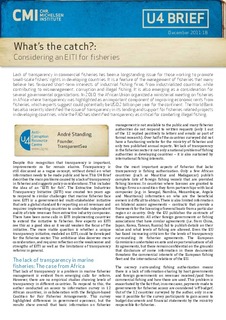| dc.contributor.author | Standing, André | |
| dc.date.accessioned | 2018-01-04T08:18:49Z | |
| dc.date.available | 2018-01-04T08:18:49Z | |
| dc.date.issued | 2011-12-07 | |
| dc.identifier | oai:www.cmi.no:4308 | |
| dc.identifier.citation | Bergen: Chr. Michelsen Institute (U4 Brief 2011:18) 4 p. | |
| dc.identifier.uri | http://hdl.handle.net/11250/2474917 | |
| dc.description.abstract | Lack of transparency in commercial fisheries has been a longstanding issue for those working to promote small-scale fishers’ rights in developing countries. It is a feature of the management of fisheries that many believe has favoured short-term interests of industrial fishing firms from industrialized countries, while contributing to mismanagement, corruption and illegal fishing. It is also emerging as a consideration for several governmental organizations. In 2010, the African Union organized a ministerial meeting on fisheries in Africa where transparency was highlighted as an important component of improving economic rents from fisheries, which experts suggest could potentially be USD 2 billion per year for the continent. The World Bank has also recently identified the issue of transparency in its lending and support for fisheries related projects in developing countries, while the FAO has identified transparency as critical for combating illegal fishing. | |
| dc.language.iso | eng | |
| dc.publisher | Chr. Michelsen Institute | |
| dc.relation | U4 Brief | |
| dc.relation | 2011:18 | |
| dc.relation.ispartof | U4 Brief | |
| dc.relation.ispartofseries | U4 Brief 2011:18 | |
| dc.relation.uri | https://www.cmi.no/publications/4308-whats-the-catch | |
| dc.subject | Natural Resource Management | |
| dc.subject | Corruption | |
| dc.subject | Marine Fisheries | |
| dc.subject | Transparency | |
| dc.title | What's the catch? Considering an EITI for fisheries | |
| dc.type | Report | |
